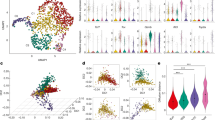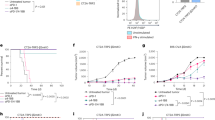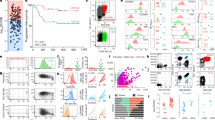Abstract
Cancers express antigens that are targets for specific cytotoxic T lymphocytes (CTLs)1,2. However, cancer cells are genetically unstable3. Consequently, sub-populations of cancer cells that no longer express the target antigen may escape destruction by CTLs and grow progressively1,4,5,6,7,8,9,10,11,12,13. We show that cytotoxic T cells indirectly eliminate these antigen loss variants (ALVs) in a model system when the parental cancer cells express sufficient antigen to be effectively cross-presented by the tumor stroma. When the parental tumor expressed lower levels of antigen, cytotoxic T cells eradicated the antigen-positive parental cancer cells, but the ALVs escaped, grew and killed the host. By contrast, when the parental tumor expressed higher levels of antigen, cytotoxic T cells eradicated not only the parental cancer cells but also the ALVs. This 'bystander' elimination of ALVs required stromal cells expressing major histocompatibility complex (MHC) molecules capable of presenting the antigen, and occurred in tumors showing evidence of stromal destruction. ALVs were apparently eliminated indirectly when tumor-specific CTLs killed stromal cells that were cross-presenting antigen produced by and released from antigen-positive cancer cells. These results highlight the general importance of targeting the tumor stroma to prevent the escape of variant cancer cells.
This is a preview of subscription content, access via your institution
Access options
Subscribe to this journal
Receive 12 print issues and online access
$209.00 per year
only $17.42 per issue
Buy this article
- Purchase on Springer Link
- Instant access to full article PDF
Prices may be subject to local taxes which are calculated during checkout




Similar content being viewed by others
References
Ward, P.L., Koeppen, H.K., Hurteau, T., Rowley, D.A. & Schreiber, H. Major histocompatibility complex class I and unique antigen expression by murine tumors that escaped from CD8+ T-cell-dependent surveillance. Cancer Res. 50, 3851–3858 (1990).
Boon, T. & van der Bruggen, P. Human tumor antigens recognized by T lymphocytes. J. Exp. Med. 183, 725–729 (1996).
Nowell, P.C. The clonal evolution of tumor cell populations. Science 194, 23–28 (1976).
Khong, H.T. & Restifo, N.P. Natural selection of tumor variants in the generation of “tumor escape” phenotypes. Nat. Immunol. 3, 999–1005 (2002).
Dunn, G.P., Bruce, A.T., Ikeda, H., Old, L.J. & Schreiber, R.D. Cancer immunoediting: from immunosurveillance to tumor escape. Nat. Immunol. 3, 991–998 (2002).
Vasmel, W.L., Sijts, E.J., Leupers, C.J., Matthews, E.A. & Melief, C.J. Primary virus-induced lymphomas evade T cell immunity by failure to express viral antigens. J. Exp. Med. 169, 1233–1254 (1989).
Lee, K.H. et al. Functional dissociation between local and systemic immune response during anti-melanoma peptide vaccination. J. Immunol. 161, 4183–4194 (1998).
Urban, J.L., Holland, J.M., Kripke, M.L. & Schreiber, H. Immunoselection of tumor cell variants by mice suppressed with ultraviolet radiation. J. Exp. Med. 156, 1025–1041 (1982).
Uyttenhove, C., Maryanski, J. & Boon, T. Escape of mouse mastocytoma P815 after nearly complete rejection is due to antigen-loss variants rather than immunosuppression. J. Exp. Med. 157, 1040–1052 (1983).
Schmollinger, J.C. et al. Melanoma inhibitor of apoptosis protein (ML-IAP) is a target for immune-mediated tumor destruction. Proc. Natl. Acad. Sci. USA 100, 3398–3403 (2003).
Yee, C. et al. Adoptive T cell therapy using antigen-specific CD8+ T cell clones for the treatment of patients with metastatic melanoma: in vivo persistence, migration, and antitumor effect of transferred T cells. Proc. Natl. Acad. Sci. USA 99, 16168–16173 (2002).
Jager, E. et al. Immunoselection in vivo: independent loss of MHC class I and melanocyte differentiation antigen expression in metastatic melanoma. Int. J. Cancer 71, 142–147 (1997).
Marincola, F.M., Jaffee, E.M., Hicklin, D.J. & Ferrone, S. Escape of human solid tumors from T-cell recognition: molecular mechanisms and functional significance. Adv. Immunol. 74, 181–273 (2000).
Ochsenbein, A.F. et al. Roles of tumour localization, second signals and cross priming in cytotoxic T-cell induction. Nature 411, 1058–1064 (2001).
Hanson, H.L. et al. Eradication of established tumors by CD8+ T cell adoptive immunotherapy. Immunity 13, 265–276 (2000).
Mullen, C.A., Urban, J.L., Van Waes, C., Rowley, D.A. & Schreiber, H. Multiple cancers. Tumor burden permits the outgrowth of other cancers. J. Exp. Med. 162, 1665–1682 (1985).
Zhang, Y. et al. Inducible site-directed recombination in mouse embryonic stem cells. Nucleic Acids Res. 24, 543–548 (1996).
Spiotto, M.T. et al. Increasing tumor antigen expression overcomes “ignorance” to solid tumors via crosspresentation by bone marrow-derived stromal cells. Immunity 17, 737–747 (2002).
Udaka, K., Wiesmuller, K.H., Kienle, S., Jung, G. & Walden, P. Self-MHC-restricted peptides recognized by an alloreactive T lymphocyte clone. J. Immunol. 157, 670–678 (1996).
Markiewicz, M., Brown, I. & Gajewski, T. Death of peripheral CD8+ T cells in the absence of class I MHC is Fas-dependent and not blocked by Bcl-XL . Euro. J. Immunol. 33, 17–26 (2003).
Garcia, K.C. et al. αβ T cell receptor interactions with syngeneic and allogeneic ligands: affinity measurements and crystallization. Proc. Natl. Acad. Sci. USA 94, 13838–13843 (1997).
Dutz, J.P., Tsomides, T.J., Kageyama, S., Rasmussen, M.H. & Eisen, H.N. A cytotoxic T lymphocyte clone can recognize the same naturally occurring self peptide in association with a self and nonself class I MHC protein. Mol. Immunol. 31, 967–975 (1994).
Dudley, M.E. et al. Cancer regression and autoimmunity in patients after clonal repopulation with antitumor lymphocytes. Science 298, 850–854 (2002).
Singh, S., Ross, S.R., Acena, M., Rowley, D.A. & Schreiber, H. Stroma is critical for preventing or permitting immunological destruction of antigenic cancer cells. J. Exp. Med. 175, 139–146 (1992).
Qin, Z. & Blankenstein, T. CD4+ T cell–mediated tumor rejection involves inhibition of angiogenesis that is dependent on IFN γ receptor expression by nonhematopoietic cells. Immunity 12, 677–686 (2000).
Plautz, G.E., Mukai, S., Cohen, P.A. & Shu, S. Cross-presentation of tumor antigens to effector T cells is sufficient to mediate effective immunotherapy of established intracranial tumors. J. Immunol. 165, 3656–3662 (2000).
Valujskikh, A., Lantz, O., Celli, S., Matzinger, P. & Heeger, P.S. Cross-primed CD8+ T cells mediate graft rejection via a distinct effector pathway. Nat. Immunol. 3, 844–851 (2002).
Garin-Chesa, P., Old, L.J. & Rettig, W.J. Cell surface glycoprotein of reactive stromal fibroblasts as a potential antibody target in human epithelial cancers. Proc. Natl. Acad. Sci. USA 87, 7235–7239 (1990).
Niederman, T.M. et al. Antitumor activity of cytotoxic T lymphocytes engineered to target vascular endothelial growth factor receptors. Proc. Natl. Acad. Sci. USA 99, 7009–7014 (2002).
O'Reilly, M.S. et al. Angiostatin: a novel angiogenesis inhibitor that mediates the suppression of metastases by a Lewis lung carcinoma. Cell 79, 315–328 (1994).
Acknowledgements
We thank B. Jabri and B. Meresse for excellent discussions; P. Ohashi and H. Hengartner for the cancer cell lines; A. Ma and M. Mescher for the OT-1 mice; M. Reth for the MerCreMer expression vector; H. Auer for synthesis of the SIYRYYGL peptide; C. Cham, T. Phillips and G. Beck-Engesser for technical advice; and The University of Chicago Immunology Applications Core Facility for technical assistance with flow cytometry. This work was supported by National Institutes of Health grants RO1-CA22677, RO1-CA37516 and PO1-CA97296, University of Chicago Cancer Research Center grant CA-14599, and a preclinical grant from the Cancer Research Institute. M.T.S. is a recipient of training grant HD 07009.
Author information
Authors and Affiliations
Corresponding author
Ethics declarations
Competing interests
The authors declare no competing financial interests.
Supplementary information
Rights and permissions
About this article
Cite this article
Spiotto, M., Rowley, D. & Schreiber, H. Bystander elimination of antigen loss variants in established tumors. Nat Med 10, 294–298 (2004). https://doi.org/10.1038/nm999
Received:
Accepted:
Published:
Issue Date:
DOI: https://doi.org/10.1038/nm999
This article is cited by
-
Isoginkgetin derivative IP2 enhances the adaptive immune response against tumor antigens
Communications Biology (2021)
-
Long-distance modulation of bystander tumor cells by CD8+ T-cell-secreted IFN-γ
Nature Cancer (2020)
-
Angiogenic factor-driven inflammation promotes extravasation of human proangiogenic monocytes to tumours
Nature Communications (2018)
-
Epidemiology and biology of relapse after stem cell transplantation
Bone Marrow Transplantation (2018)
-
Identification of essential genes for cancer immunotherapy
Nature (2017)



